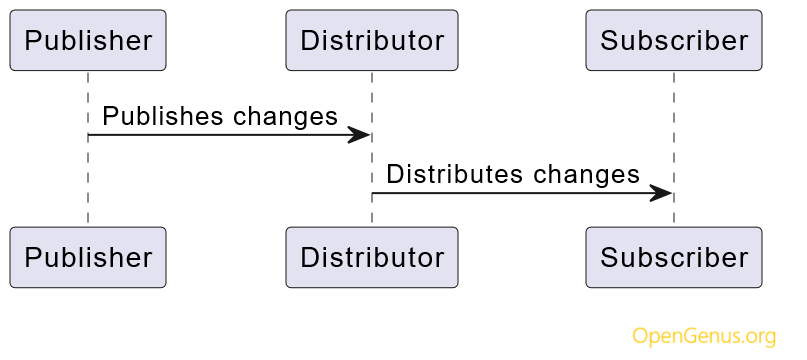
Open-Source Internship opportunity by OpenGenus for programmers. Apply now.
Transactional replication is a popular method for keeping multiple SQL Server instances synchronized by capturing changes from one server (publisher) and applying them to others (subscribers). We will explore its key aspects along with code samples and best practices.
Table Of Contents:
- Setting Up an Example of Transactional Replication
- How Transactional Replication Works
- Comparison with Similar Concepts
- Applications
- Quiz
- Key Takeaways

Let us set up a simple example of transactional replication step by step:
Publisher Setup:
USE master;
GO
CREATE DATABASE MyTestDB;
GO
USE MyTestDB;
GO
CREATE TABLE Person(ID INT PRIMARY KEY IDENTITY, Name NVARCHAR(100));
INSERT INTO dbo.Person VALUES ('John Doe'),('Jane Smith');
GO
-- Create publication
EXEC sp_addpublication @publication = 'MyPublication',
@database = 'MyTestDB';
-- Add table to publication
EXEC sp_addarticle @publication = 'MyPublication',
@article = 'Person',
@source_owner = 'dbo',
@source_object = 'Person',
@type = 'logbased',
@description = '';
GO
Explaination of Code:
-
It Creates a database named "MyTestDB."
-
Within "MyTestDB," creates a table named "Person" with two columns: "ID" and "Name".
-
Inserts two rows into the "Person" table.
-
Creates a publication named "MyPublication" for "MyTestDB."
-
Adds the "Person" table to the publication, specifying log-based replication.
-
Basically It sets up a database, a table, and establishes transactional replication for the table.
Subscription Setup:
-- On subscriber side
CREATE DATABASE MySubscribedDB;
GO
USE MySubscribedDB;
GO
-- Define push subscription
EXEC sp_addsubscription @publication = 'MyPublication',
@subscriptiondb = 'MySubscribedDB',
@destination_db = '',
@sync_type = 'automatic',
@subscription_type = N'Push',
@update_mode = N'read only',
@subscriber_security_mode = 1;
GO
-- Start Agent
EXEC sp_startpublication_snapshot @publication = 'MyPublication';
GO
Explaination of Code :
-
Creates a database named "MySubscribedDB".
-
Defines a push subscription for "MyPublication" to sync with "MySubscribedDB."
-
Specifies automatic synchronization, push subscription type, read-only mode, and starts the replication agent.
-
In essence, it prepares the subscriber database for receiving and updating data through transactional replication.
How Transactional Replication Works:
Transactional replication uses a publish-and-subscribe model where changes made to the published database are captured and then propagated to the subscribers. The process can be broken down into three main steps:
-
Snapshot Generation: A snapshot of the entire published database or specific articles (tables, views, etc.) is taken at regular intervals. This snapshot includes schema and data and serves as the initial state for all new subscribers.
-
Change Data Capture: As transactions occur on the published database, they are recorded by the distribution agent and stored in the distribution database. These change records include information about which rows were inserted, updated, or deleted.
-
Distribution: The distribution agent applies the changes to the subscription databases according to their schedule and settings. Changes are applied sequentially, ensuring consistency between the publisher and subscribers.
Comparison with similar concepts:
| Feature | Transactional Replication | Change Tracking | Change Data Capture (CDC) | AlwaysOn Availability Groups |
|---|---|---|---|---|
| Purpose | Replicate data changes in real-time | Lightweight mechanism for tracking changes | Detailed audit trail at the column level | High availability, data protection through synchronization |
| Granularity | Individual transactions | Changes at the row level | Changes at the column level | Operates at the database level |
| Latency | Near real-time with potential latency | Changes tracked as they occur, polled periodically | Changes captured as they occur, polled periodically | Near real-time synchronization between replicas |
| Use Case | Reporting, load balancing, data distribution | Identify modified rows within a timeframe | Auditing, historical changes, synchronizing data warehouses | High availability, disaster recovery, automatic failover |
In summary, these features serve different purposes within SQL Server:
- Transactional Replication: For real-time replication of data.
- Change Tracking: For lightweight tracking of changes at the row level.
- Change Data Capture (CDC): For detailed auditing of changes at the column level.
- AlwaysOn Availability Groups: For high availability and data protection through database-level synchronization.
Limitations of Transactional Replication
While Transactional replication is a powerful feature in SQL Server that allows the replication of changes made to a database in near real-time. However, like any technology, it has its limitations. Some common limitations of transactional replication are:
-
Latency:
While transactional replication provides near real-time data replication, there can still be some latency between changes made on the publisher and their replication to subscribers. The latency depends on factors such as network speed, the volume of changes, and the configuration of the replication. -
Network Overhead:
Replicating every transaction to subscribers can create significant network overhead, especially in high-volume transaction environments. This can affect the overall performance of the network. -
Consistency:
Ensuring consistency across all nodes can be challenging. If there are conflicts or errors during replication, it may lead to inconsistencies between the publisher and subscribers. -
Initial Snapshot:
Transactional replication requires an initial snapshot of the entire data set to be transferred to the subscribers before real-time replication begins. This snapshot process can be time-consuming and resource-intensive, especially for large databases. -
Schema Changes:
Schema changes, such as adding or modifying columns, may require additional steps in transactional replication. Managing schema changes can add complexity to the replication process. -
Limited to SQL Server:
Transactional replication is specific to SQL Server and may not be compatible with other database management systems.
Applications
Transactional replication is commonly used in various scenarios such as:
- Geographically dispersed systems
- Reporting servers
- Load balancing
- Backup and disaster recovery
Question
Which type(s) of replication does SQL Server support?
Question
Regarding modifying replicated schema, which statement is correct?
Key Takeaways Transactional replication
- Transactional replication keeps multiple SQL Server instances synchronized.
- It involves a publisher, distributor, and subscriber setup
- Real-world usage covers geographical dispersion, load balancing, backup, and disaster recovery.Map.
